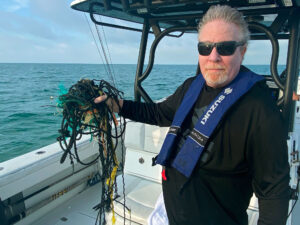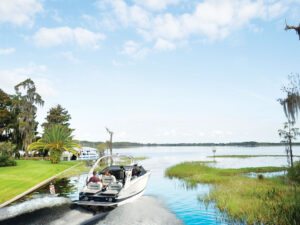Steering, throttle and trim are the three control elements of most boats. Many boaters intuit steering and throttle. Both are analogous to vehicles previously mastered — an automobile or a riding lawn mower.
Trim is another matter. It confounds many boaters to the point of distraction.
Trimming changes the propeller shaft angle relative to the boat. When the boat is on plane and the prop shaft is parallel with the water’s surface, the trim is said to be neutral or zero. In this state, all the propeller force is pushing the boat forward. When you press the trim button down, the gear case moves closer to the transom until it bottoms out at about negative 6 degrees. Now the prop shaft is aimed down 6 degrees, and some of the force lifts the boat’s stern.The boat hull acts like a teeter-totter; when you lift the stern, the bow goes down. Push the trim button up and the gear case rotates away from the transom, and once beyond zero, the prop shaft is pointed upward. In this state, some of the thrust is pressing the stern down and thus lifting the bow. All you really need to know is that when you push the trim button down, the bow goes down. Button up equals bow up.
To get on plane efficiently, start with the trim all the way down (listen to the sound of the trim pump, which will change tone when it bottoms out). When you nail the throttle, some of the prop thrust will lift the stern and help roll the bow down as the boat climbs on plane. Try to get on plane with the drive trimmed up and the bow will point skyward, blocking your view and wasting fuel as the boat struggles to plane off.
Once on plane, you use the trim to lift the bow so the hull is skimming along on the aft third of the running surface. Bump that trim button up and you’ll feel the steering lighten, the bow rise, and speed increase. Notice that the spot where spray breaks off the hull is moving aft. Drag is significantly reduced, and efficiency is enhanced.
It’s possible to over-trim. At high boat speeds, you may notice a change in tone behind the boat as the prop starts aerating and losing bite. On GPS, you’ll see the boat speed decrease, even as engine rpm increases. Bump the trim button down a little and the prop will hook back up with the water. Porpoising — the bow bobbing up and down — is caused by over-trimming at cruising speed; there’s no longer enough wetted surface to support the weight of the boat. The bow drops as the boat falls off plane, then it regains plane and starts the bobbing motion. Break the cycle by trimming down a little until the porpoising stops, or increase boat speed slightly to create more lifting force under the hull. In a head sea, trimming down will soften the ride by allowing the sharper deadrise of the bow to slice through chop. In a following sea, trim the bow up to prevent the bow from rooting (digging in), which will make steering easier.
The weight of passengers, fuel, and even heavy coolers will change the way a boat reacts to trim. So learn to trim your boat by feel; trim until the boat feels light and happy. And get in the habit of trimming down as the boat comes off plane. Then you’ll be ready to take off again in style.









